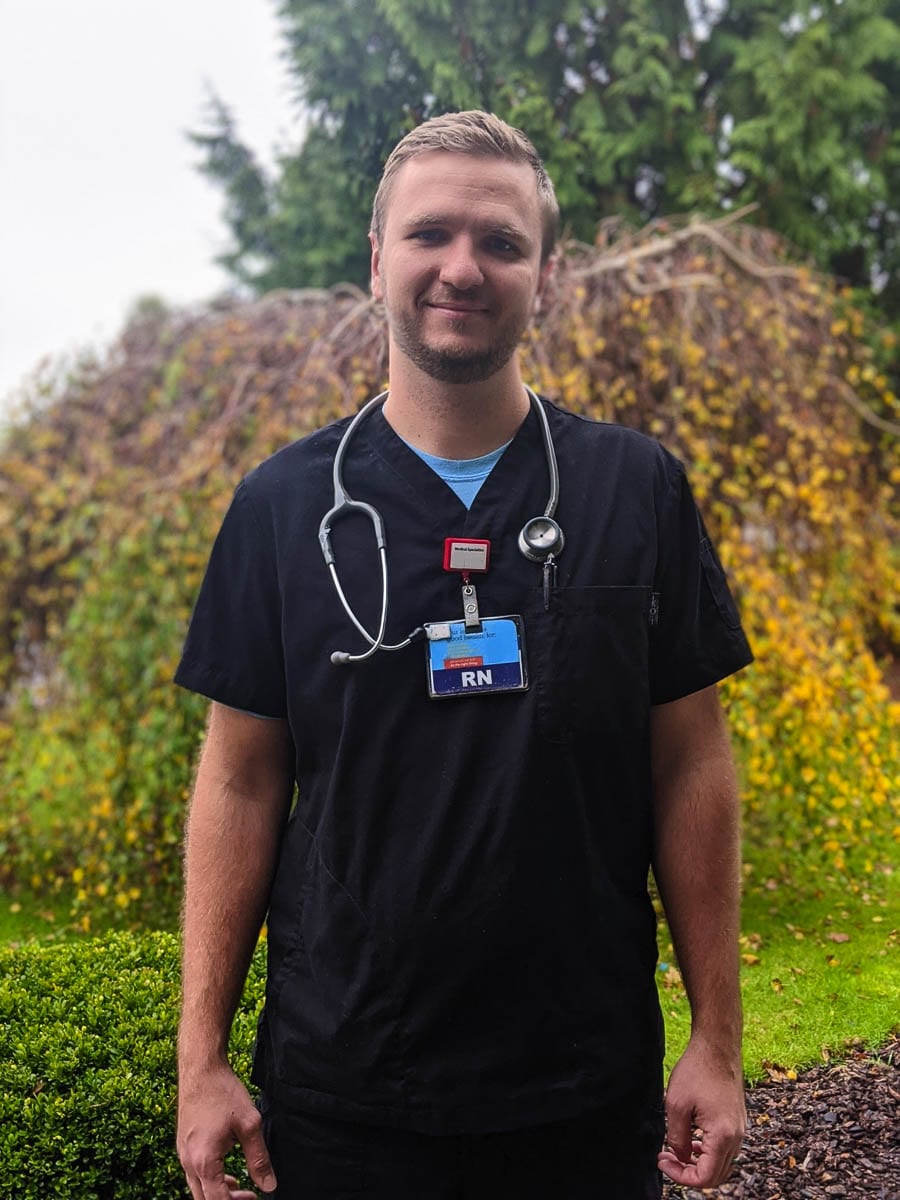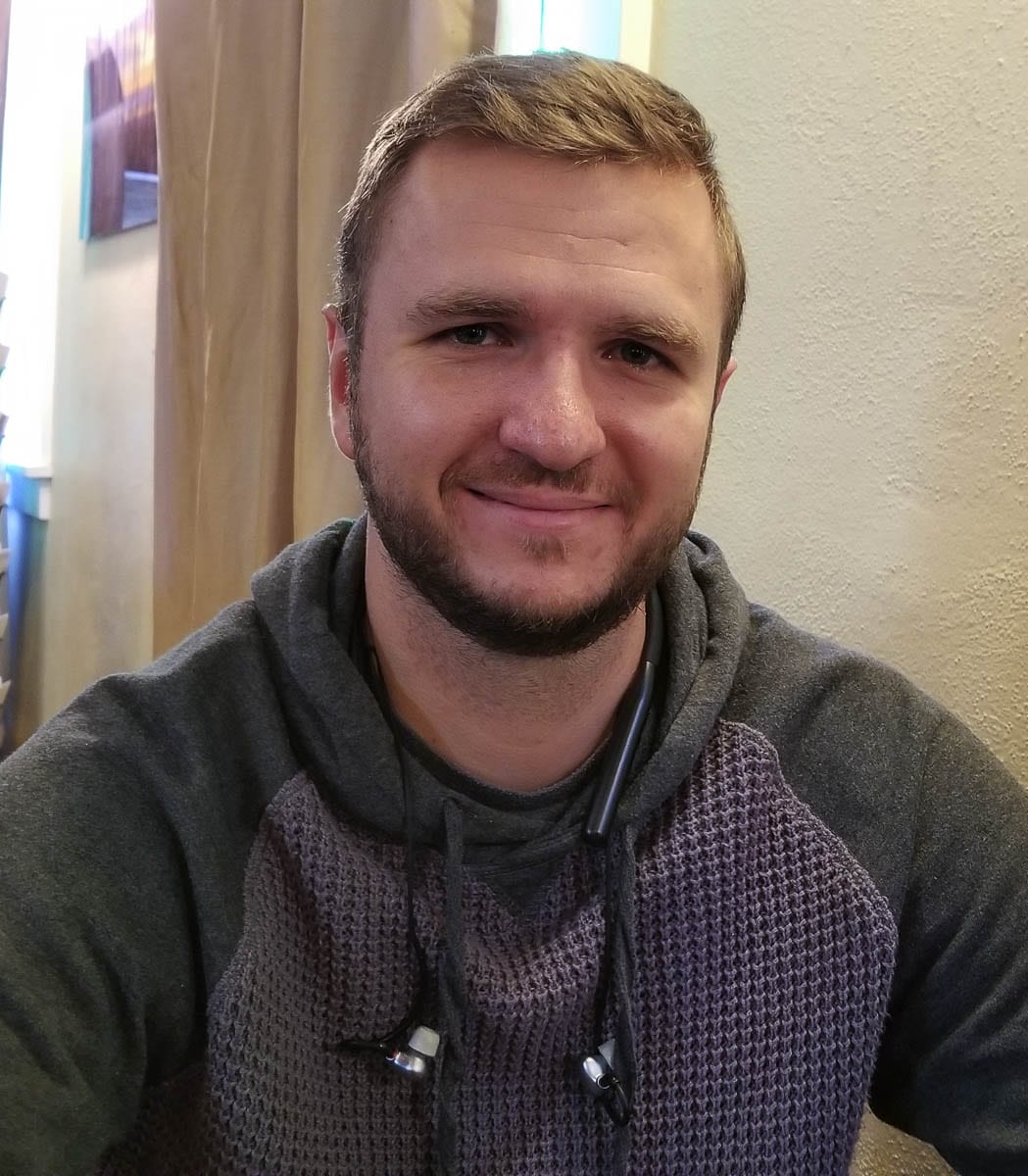Denis Kolomitsev shares experiences and observations on caring for patients who have contracted the virus
The front line soldiers of healthcare are the nurses and hospital support staff dealing with patients day in and day out. Denis Kolomitsev is a nurse at a local hospital, working in their medical unit. He’s seen first hand the impact of COVID-19 on healthcare.
His 90-year old grandfather passed away with COVID. He was diabetic as well. “But when you’re 90, COVID gets in line,” Kolomitsev said. “Cuz a bunch of other things are in line to take you.“ Kolomitsev’s grandmother only had very mild, flu-like symptoms, but she did test positive for COVID after his grandfather passed.
“The funeral service was really weird,” he said. “It was the immediate family, the immediate kids of my grandfather sitting in their cars. They watched him from a distance being put into the ground.” The family still hasn’t been able to have a memorial service for him, due to COVD restrictions.
A 64-year-old uncle of Kolomitsev had the virus as well and was on a ventilator for a little over a month, but hospitalized for nearly two months before recovering. ”Almost everyone in the hospital was thinking he was going to pass, but he pulled through,“ he said. “I guess the official statistics are that if you’re over 70, the survival rate is about 94 percent. But yeah, he was on the cusp, he got it really bad, but he survived.”
Both instances were in the early days of the pandemic, when information about the virus wasn’t as available as it is today.
“COVID is definitely a real thing, contrary to the naysayers,” he said. “People are dying from something.”

Kolomitsev talked about the challenges an average person has in sorting through all the information.
“My general impression is that it’s political pseudoscience,” he said. “There’s definitely a lot of science, but there’s so many doctors out there that it’s sometimes hard to understand who to listen to, and who’s the authority.
“Because it’s such a new thing, it seems everyone wants to come across like they know, something,” he said. “So you really don’t know. We’re all really kind of learning. We’re all really just trying to wrap our heads around it and how to deal with it and who it affects most and what the best approach is.”
At the hospital, Kolomitsev works on the medical floor. He cares for patients with many ailments, including those with COVID-19. He explained that many patients come in for high blood sugar, or a broken hip, or some other ailment. And if their treatment involves something invasive like surgery or intubation or anesthesia, they are then tested for the virus. That in part, is for the safety of the staff. Otherwise, patients are not automatically tested.
“A lot of the COVID cases are incidental findings,” he said. The patients are admitted for some other ailment or surgery. A COVID-19 test is done and they discover the patient is also testing positive for the virus.
“I’ve had patients that had symptoms,” he said. “In fact most patients that I had, had symptoms with COVID, of some kind. But they were very light, for the most part.” Some patients are surprised to learn they have the virus; others have such bad symptoms they believe they have COVID.
Kolomitsev doesn’t believe any patient on his floor has passed away from COVID since the beginning of the pandemic. There have been COVID deaths on other floors, but not on his medical floor. It should be noted he doesn’t have information on all the patients on his floor, just the ones assigned to him. Therefore it could be that some have passed from COVID. ”The overwhelming number of people, they get COVID and then they leave and they go home,” he said.
Kolomitsev shared another interesting tidbit. “There’s a lot of repeat cases of COVID not because they get COVID again, but because we now know that COVID sticks around. It can stick around in your system after you stop having symptoms for up to 90 days.” He believes you can’t pass it to others after 14 days, but you can test positive for up to 90 days.
“We had one very young patient who had COVID at one point with some mild symptoms,” he said. The patient was released, but came back for a non-COVID related issue a month later. The patient still tested positive for the virus.
Kolomitsev recently had one patient admitted for something else fairly serious. The patient passed away the next day. When they got the COVID test results, the patient tested positive; but that wasn’t what the patient was admitted to the hospital for.
Right now the policy in his hospital is for the staff to wear a mask and glasses or goggles that wrap around their eyes, basically the whole 12 hours of a shift. Whenever they go into any patient’s room, regardless of COVID or not, they wear gloves in addition to the mask and goggles. They don’t have to wear gowns into non-COVID rooms.
If they are treating a COVID positive patient who has an aerosolized procedure, like a nebulization treatment or some breathing treatment like mist breathing, then they would be on airborne precautions for two hours.
“You would have to have a PAPR to come into that room for two hours after the procedure. After that it’s back to just mask and gloves,” he said. (A powered air purifying respirators means an air-purifying respirator that uses a blower to force the ambient air through air-purifying elements to the inlet covering.)
Early on, his hospital had a dedicated COVID unit. But it put a great deal of stress on staff. As they learned more about the virus, patients are now cared for on multiple floors of the hospital, including the Intensive Care Unit (ICU).
Kolomitsev shared that they have not had any staff members come down with COVID until just recently. “But it’s not very clear whether it (the transmission) was from our unit or not. Was it at the hospital or at home,” he said.
Kolomitsev believes this speaks well for the safety precautions health providers are taking to protect themselves and their patients. He spoke of the teamwork that happens on the hospital floor. “We help each other all the time. We go in and out of each other’s rooms. It’s really near impossible to take care of keeping the unit running without us working together and helping each other.”
The hospital has two different tests for the virus. One delivers results in about half an hour, but those are not widely available. The standard COVID test delivers results in about 24 hours.
He mentioned that the hospital employees do not get tested for the virus unless they have fairly obvious COVID-like symptoms, or if they have had a known exposure to a COVID positive patient without proper PPE. Most of the time the employee goes home and quarantines for 14 days.
Kolomitsev noted that both in Clark County and in Washington state, there is an increase in the number of tests, an increase in the number of COVID positives being reported, but that the death rate appears to be fairly flat. ”But what about the death rate? That’s hardly ever mentioned,” he said. “The focus is on the increasing number of cases.
“More COVID positive cases are coming in,” he said. “I think what we see is that the recoveries are faster now, maybe thanks to remdesivir. And, at least from what I hear from the doctors and the staff of the hospital, is that there aren’t more people dying proportional to the increased number of tests.”
What he is seeing, is shorter hospital stays and shorter recovery times, when it comes to COVID; at least on his floor.
Kolomitsev mentioned that hospitals are getting busier. But it’s because people delayed certain procedures and stayed home earlier in the year. They were concerned about getting COVID four to six months ago. “Our surgical department was closed,” he said. “The hospital was a ghost town for the first couple months.”
But now the delayed medical care is being addressed, and he’s seeing it with increased numbers of people in the hospital. There was a backlog of demand for hospital services.

Clark County Today asked Kolomitsev about the training and procedures staff followed during the early days of the pandemic.
“Sometimes it got very frustrating, especially for the manager because there was a point at which the changes in policy would happen several times a day,” he said. “The manager got tired of posting printouts and sending emails, because by the time it was done, the policies changed. It was just constant change.
“There are a lot of people who have a lot of opinions about how COVID should be handled, or should have been handled at the beginning. But the reality was nobody knew back then how to handle it,” said Kolomitsev, who also spoke about the constant policy changes. “You have to wear your mask, maybe not wear a mask. What about goggles, what about gowns? Should we reuse the gowns? Should we not?”
With all the changes, nurses and staff would get confused and frustrated at times. “Was I supposed to be caring for that patient or reading the 15 emails in my inbox,” he said.
Today, Kolomitsev says they’re seeing an increase in total cases, many of whom are younger. “I would say a lot of the younger patients who have COVID, a lot of them are incidental,” he said. “Very few that I know of, came in primarily because they thought they have COVID. They’re either asymptomatic or only mild symptoms.”
“Who knows, maybe I already had it,” he said. “In fact, many of us at the hospital look at it as if we probably had it.” Some of the older nurses and staff are a bit more anxious about catching the virus, and that is understandable.
Clark County Today asked Kolomitsev: What would you recommend for the average person? How should they be cautious? What precautions are reasonable?
“As I said, in the very beginning, I think a lot of it is political pseudoscience, you know, not real science,” he said. ”And that’s mainly because a lot of the scientific data is being plucked out of context and then used as a cudgel or, or a whip, or something. But at this point, we have enough information, I think, to make a more balanced decision, have a more balanced approach to the precautions for the general public. And what we have now I don’t think it’s balanced.
“I’m not in any position to tell people exactly what should happen. But I listened to doctors, I interact with COVID patients, I interact with managers and the recommendation I would say is we know who it affects,’’ Kolomitsev said.
“Why don’t we recommend that those who the virus affects more should have a greater amount of precaution and restriction recommended to them?’’ Kolomitsev asked. Those who it affects less, go go on about your life. I think that would be the balanced approach.
“Now, someone might say, well, it might not affect me, but what about I have older people that I take care of or live with grandma and grandpa. Okay, well you’re an adult. Count yourself as someone who is at risk by your proximity to the older folks.
“For those who are immunocompromised, whether you’re on chemo, whether you have other conditions that compromise your immune system. You might have Crohn’s disease, you might have diabetes, you might have something else that you’re dealing with that would potentially make it hard for your body to fight off COVID. So take that into consideration. And you’ll be the one that takes the precautions.
“Everyone else go about your life. Go back to work, open your business, to those who are not at risk, those who are not in those categories,’’ he said. “I think our local government can make that kind of distinction, and make the recommendation and say we’re going to open businesses But we would like to recommend restrictions on these categories of people. And please stay home, if you’re in this category of people.”
“I think the government is capable of doing and our legislators are capable of making those recommendations. Instead, what we see is it’s a blanket intervention on everyone.”
Kolomitsev was then asked what he has observed for the “average” COVID patient on his medical floor?
“Most COVID positive patients are on the nasal tube for oxygen,’’ he said. “They get remdesivir if they are there for COVID, if they’re not an incidental positive test. In fact, some patients who are COVID positive do not get remdesivir because their symptoms are just not there or are so mild.
“So for you to get remdesivir, you would likely need to be symptomatic, with COVID-like symptoms,’’ he said. “COVID is a type of infection that primarily affects the lungs by inflaming the lungs, thereby making it very difficult to breathe, Then the immune system is overwhelmed and trying to deal with inflammation. The way I understand it is when COVID gets into your system, it uses your immune system against you.
“Basically there’s an excessive immune response. And so what you have is your immune system attacks your lungs. Your lungs become very, very inflamed. That’s why we give dexamethasone because it’s a steroid, and steroids help decrease inflammation thereby helping patients breathe easier.”
Kolomitsev is a first generation immigrant. “We moved here on refugee status in 1999. My grandpa did some prison time for his faith in Russia.”
He was born on the northern end of the Black Sea and then lived in Ukraine for about five years. His family emigrated to Clark County before moving to Fresno, California. His father went to seminary in California, and then the family moved back to Clark County in 2007.




